Oceans of Dharma
Can investigating India's medieval dams provide a model for bringing water to a billion people?
While Kathleen Morrison, an anthropologist from the University of Chicago, answers her phone, I have a moment to take in the stunning view from the top of Matanga Hill. There are dozens of other hills like this one, piles of smooth granite boulders that resemble oversized river cobbles. Lush paddies and fields of bananas and sugarcane lap against them. This, according to legend, was the forest domain of the monkeys, home of monkey-god Hanuman, in the ancient Sanskrit epic The Ramayana. Through a midday haze that gives everything a painterly quality, it's also clear that the landscape is studded with buildings—the ruins known as Vijayanagara (also called Hampi, the name of a modern village here). Today, the site in the Indian state of Karnataka is crawling with pilgrims, tourists, and neo-hippies. But it was once the sprawling, wealthy capital of an empire that ruled most of southern India from the 14th to 16th century, during a time called the Middle Period, when the subcontinent was a hodgepodge of shifting empires, sultanates, and kingdoms. The rulers here had a sense of the monumental—there are temple complexes, columned bazaars, palaces, baths, and elephant stables, in addition to irrigation canals from the braided channels of the Tungabhadra River. From up here, it seems like a fine place to have a big city.
"This is a really tricky place to have a big city," Morrison had told me a few minutes before. Beyond the reach of the canals, this is one of the drier parts of southern India. As in many ancient cities—Petra and Angkor come to mind—water played a critical role in Vijayanagara's political and physical landscapes. On the horizon two miles away is the vegetation-choked, 14th-century Kamalapura Reservoir, which provided water for several hundred thousand people. I try to imagine the groves it now irrigates as a dense metropolis.
Morrison hangs up the phone. The call was from her team, excavating a site across the river. Their Hindustan Ambassador—India's classically boxy sedan—has broken down. We have the other car, so it's time to go.
Prior to this dig, Morrison's historical, archaeological, and paleoenvironmental research focused on a landscape-wide study of the reservoirs that served Vijayanagara. She found that the old waterworks have a surprising significance for a thirsty nation (70 percent of its 1.1 billion people rely on irrigation-supported agriculture) grappling with disruptive megadams and dwindling groundwater.
The idea that past or indigenous cultures employed some kind of forgotten wisdom in managing their resources is a common theme in Indian development literature. "New traditionalism," as the approach is known, posits that large, state-run projects such as big dams are inferior to traditional forms of water management, which are described as community-run, small-scale, sustainable, and fair in their distribution of water. It is an admirable vision, but what happens when, as Morrison found, the wisdom of the past isn't quite what we would like it to be?
Morrison, trim and tireless, began working here as a graduate student in 1985, mapping temples and royal structures. Her interests in agriculture and non-elite populations drew her to the city's periphery, where she collaborated with Carla Sinopoli, now at the University of Michigan. They have worked together for 20 years and codirected the decadelong Vijayanagara Metropolitan Survey, the first comprehensive study of the region. Despite long days spent walking the landscape, it sounded like a real adventure—dodging tree snakes in thick banana groves and stumbling upon overgrown, undocumented 15th-century temples. Among other finds, including Early Historic sites along the river (her current excavation site among them), they saw evidence of a boom in construction and population in the early 16th century, not long before the Hindu city was attacked by northern sultanates and abandoned in 1565. "I figured there must have been a process of intensification of agriculture, an increased demand for food," says Morrison. This would require land and water beyond the urban core, such as in the dusty Daroji Valley, about 10 miles to the south. There, she documented the remains of hundreds of dams and reservoirs, from small tanks to valley-spanning berms. "The reservoirs are certainly relevant to larger questions," says Sinopoli, such as how the city related socially and economically to the countryside.
Morrison is a bit of a polymath. "I pretty much just wind up and go," she tells me, as if in warning. She digresses at times into talking about birdwatching, the history of rice, isotope analysis, and the politics of large dams. The latter subject fit well with her study of agriculture, and she saw a way to contribute an ancient perspective on a modern debate.
India has particular water challenges. Rainfall and surface water are distributed unevenly across the country, and 80 percent of its rain comes in just 100 days of monsoon, making the water difficult to store, maintain, and use. Since independence in 1947, India has welcomed gargantuan river-diverting dam projects. In 1954, at the opening of the Bhakra Nangal Dam in Himachal Pradesh, India's first prime minister, Jawaharlal Nehru, is reported to have said, "These are the new temples of India where I worship," a bold statement in a country where the temple and mosque loom large. I see a slightly bastardized and oft-quoted version of his statement—"Dams are Modern temples of India"—on a wooden sign at the Tungabhadra Dam, alongside other prescriptive aphorisms, such as "Conserve water, conserve civilization" and "For each evil act of man, pain follows like a wheel." This dam, completed in the 1950s, is just 10 miles from Vijayanagara. Despite the wonders of the city ruins, the dam attracts just as many Indian tourists—it is a monument of a contentious secular religion.
Such dams were once symbols of a powerful, independent India, examples of the way a modern state could marshal its resources to improve the lives of its people. "There was a spectacular political dimension to this, making evident the fact that the nation has arrived, that it is truly the equal of the West," says Dan Klingensmith, a historian of modern India at Maryville College in Tennessee. That vision has been tarnished, in large part because of a fevered protest movement against the Narmada Valley Development Project, a system of 3,200 small, medium, and large dams across 750 miles of the Narmada River, including the $450-million Sardar Sarovar megadam. "Big dams are to a nation's 'development' what nuclear bombs are to its military arsenal. They're both weapons of mass destruction," wrote novelist and activist Arundhati Roy in a 1999 essay attacking the project.
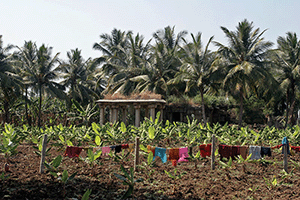
Many Vijayanagara structures are scattered across an agricultural landscape, some of which is still irrigated by 500-year-old canals and reservoirs. The city's waterworks might provide perspective on modern water management.
(Samir S. Patel)
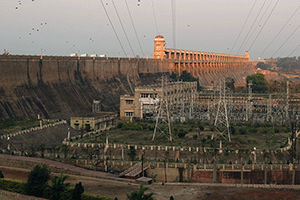
The Tungabhadra Dam, completed in the 1950s, is merely the latest large resource-management project in the Vijayanagara region. Massive waterworks were also common hundreds of years ago.
(Samir S. Patel)
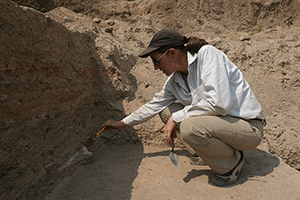
Anthropologist Kathleen Morrison, examining a non-elite Middle Period site, has spent decades studying the region around Vijayanagara's urban core, in part to understand how the city's rulers met the agricultural needs of one of the largest cities in Asia.
(Samir S. Patel)
Modern megadams are criticized for damaging the environment, displacing and dispossessing the poor, and not fulfilling their stated goals. Though the government says the Narmada Project will supply 20 to 40 million people, it will displace hundreds of thousands in one state for the benefit of those in another, and will inundate thousands of acres of forests and fields. These problems, coupled with nostalgia for the purity and simplicity of village life—no surprise in the nation of Mahatma Gandhi—made a compelling case for a return to some kind of traditional water systems. This new traditionalist idea appeals to a number of groups: hard-core nationalists, environmentalists, social reformers, and small-government advocates.
"We need to solve water and energy problems in India today. Even people violently opposed to big dams recognize that," says Morrison. "So how do you get that? If the argument is to revive old systems, we better understand them."
The Delhi-based Centre for Science and the Environment, an advocacy organization, has documented traditional systems of rainwater harvesting, which are touted as more efficient, sustainable, and democratic. David Mosse, a social anthropologist at the University of London, has approached such claims critically. Using the work of local historians, administrative records, and oral histories in Tamil Nadu, he found no evidence that indigenous methods were fair, equitable, or democratic. Rather, the building of an ancient reservoir was an act of statecraft and power. New traditionalist rhetoric is a vision of the past imprinted with modern desires, he suggests. We're seeing what we want to see.
"Some scholars and activists romanticize what happened in earlier eras, almost suggesting that social relations before capitalism and colonialism were more socially and ecologically harmonious. None of this is based on any close examination of social relations," says Amita Baviskar, an environmental researcher at the Institute of Economic Growth in Delhi.
Morrison's study of the Daroji Valley brings the landscape and reservoirs to bear on the question of whether traditional systems were more equitable, or even smaller or more sustainable than what we have today. If they are not, do such myths about the past help or hinder plans for the future?
"I really like her interest in trying to evaluate some of these claims with evidence other than the often very florid rhetoric that surrounds them in public discussion," says Klingensmith. "She's actually using archaeology."
U.V. Sriniwas has driven Morrison around Karnataka for decades, since she was 21. She calls him "the premier archaeological driver in Hampi," and they share a kind of private geography of reservoirs and other sites. He's at the wheel for a spin through the Daroji Valley.
"Things just went nuts in the 16th century," Morrison says. Migration swelled the population of Vijayanagara beyond the capacity of canal-fed fields and paddies, pushing agriculture into marginal areas, such as Daroji. The surveys showed that in the early 16th century, there was an explosion in the construction of reservoirs, which cascaded through this and other valleys, one into another. At the time, nearly half the land was dedicated to reservoirs or the fields they irrigated.
Our first stop is perhaps the greatest folly of the 16th century, Rayakere Dam. Sriniwas follows National Highway 13 as it climbs across the dam's spine to a makeshift truck stop for the overstuffed lorries that roar across India's highways. Visiting Portuguese horse trader Domingo Paes wrote in the 1520s of the construction of what was likely this dam: "In the [basin] I saw so many people at work that there must have been fifteen or twenty thousand men, looking like ants, so that you could not see the ground on which they walked." It was 91 feet high, 130 feet thick, and more than half a mile long, faced with blocks of red stone. The notion that precolonial waterworks were small and community-run flies away like my hat in the wake of a passing truck. "They were definitely pushing the limits of what was possible," Morrison shouts before we clamber down to the calm of a field below. Not only was this dam massive, it never even held water, likely because the ground was too porous. It's a valley-spanning indictment of "traditional" water management. Morrison's analyses of Daroji's pollen, siltation, and landscape changes show that many Vijayanagara-era reservoirs, including the smaller ones often championed today, were unreliable and unsustainable. They were likely to fail, experienced siltation, and were subject to heavy evaporation.
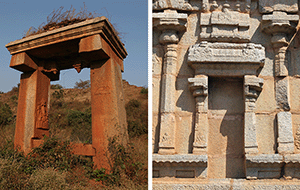
This sluice gate from the failed Rayakere Dam (left) features a carving of the Hindu god Ganesha and mimics formal temple architecture and a sculptural form called an aedicule (right, from Vijayanagara's Krishna Temple) that itself represents a temple. Morrison theorizes these gates were meant to be temples dedicated to worship of a reservoir.
(Samir S. Patel)
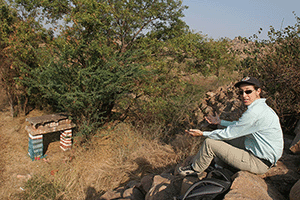
Deep in the Daroji Valley, Morrison has documented the remains of hundreds of old dams, including the valley-spanning berm of the 16th-century Dharmasagar Reservoir. Such works, some of which rival modern dams in environmental and social disruption, suggest there was no "golden age" of community-run water management in southern India. The sluice gates of the reservoir are still sites of worship today. This one is likely a fertility shrine.
(Samir S. Patel)
As Sriniwas guides the Ambassador through the valley, Morrison points out small, dry, silted-in reservoirs here and there. We stop at the place where, in Morrison and Sriniwas's private geography, their car caught fire and Sriniwas burned his hand: the Dharmasagar ("ocean of dharma") Reservoir. Not as tall but more than twice as long as Rayakere, Dharmasagar was a seasonal, valley-wide reservoir. Morrison located the dam's founding inscription on a slab among piles of thorny branches used as fences to keep goats from wandering off—the dam was created not by a village, but by a group of merchants. Religious and literary texts confirm what the inscription and the scale of these projects suggest, that India's traditional reservoirs were not just for communities. Merchants, village big men, regional politicos, and royalty all built them for political and religious favor. Large and small alike, they were used to control water to enforce social hierarchies, such as gender and caste, according to Mosse.
"The whole social structure of inequality is built around irrigation," says David Ludden, a historian of Indian development at New York University. Differential access to water is like an engine of inequity, stratifying populations by access and privilege. While some were displaced and dispossessed, those with access to water could grow luxury crops, such as rice and fruit, and institute a cash economy that further marginalized others. Dharmasagar also shows how directly damaging such works can be. The 20-foot-tall earthen wall has several chasms cut through it. "These breaches weren't necessarily just agricultural disasters," Morrison says as I pull thorns out of my shoes. "People would have died."
A breach at the two-mile-long dam at the end of the valley, which forms the still-in-use Daroji Reservoir, wiped out several villages in 1851. It's hard not to see such massive structures as just as huge, intrusive, and risky as modern dams, with similar benefits and negative social and environmental effects. The Vijayanagara Period hardly looks different from today.
"Virtually all of the flaws of the larger, modern projects can also be laid at the feet of 'traditional' reservoir irrigation in southern India," Morrison wrote in a paper she has presented at academic meetings. There was no golden age of environmental stability, egalitarian social relations, and community self-governance to restore.
India has always been enamored of its dams. Building a reservoir is listed in inscriptions alongside having a son and planting a forest as great meritorious acts. Patrons bragged about their reservoirs, which were much-discussed as political and social strategies. Morrison's work in Karnataka provides a glimpse as to why—then as now—dams and reservoirs play a disproportionate role in the Indian political imagination.
Each big reservoir we visit has sluice gates, offshore stone towers used to control the flow of water through dams and into fields below. The typical 14th- to 16th-century sluice gate consists of vertical stone slabs linked by crossbars, with a three-part molding sequence across the top, usually carved with gods or goddesses, uncannily mimicking temple architecture. As we appreciate a substantial example featuring the likeness of elephant-headed god Ganesha in the field below Rayakere Dam, Morrison says, "The sluice gates evoke temples, but they're in a sense meant to be temples."
The gates are shaped like doorways to temple sanctuaries, which are usually adorned with the same iconography —Ganesha, the goddess Lakshmi, or donor portraits. In the Virupaksha Temple complex in the urban core of Vijayanagara, Morrison points out a motif repeated on several sculptural walls—it looks exactly like a sluice gate. Called an aedicule, it is thought to stand in symbolically for other complete temples. Hindu temples also often have aquatic motifs, such as turtles and fish, on their outer walls to evoke the mythological ocean of life that surrounds the world. Sluice gates, Morrison theorizes, may be temples or gateways dedicated to productivity, prosperity, and worship of the reservoir—itself a symbolic ocean of life. I recall Nehru's quote and Morrison is one step ahead of me: "They were temples then, too."
The still-standing gates continue to hold religious importance. Some of them, at Dharmasagar, for example, seem curiously alive. Painted or with colorful cloth tied to them, they are fertility shrines, sites of active worship.
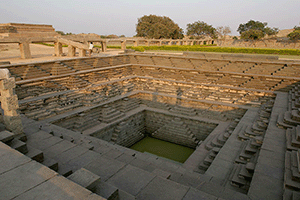
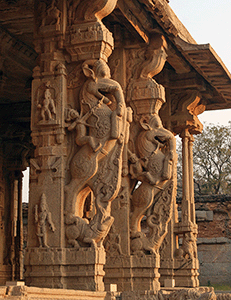
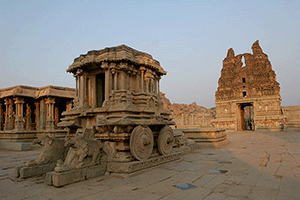
The glories of the city of Vijayanagara include the stepped tank (with stone aqueduct at rear) in the royal center and the Vitthala Temple complex. Its magnificent courtly and sacred districts would not have been possible without the city's large, extensive water system.
(Samir S. Patel)
Most serious people in the development arena separate religion from water management and understand the flaws of traditional systems. "I do not think it is anybody's case that we need to replicate the techniques and management systems of the old ages," says Himanshu Thakkar of the South Asia Network on Dams, Rivers, and People. "But what made it possible for the traditional systems to survive so long can provide useful pointers for our current situation." He proposes a multipronged approach including traditional rainwater harvesting, watershed development, and cropping patterns, combined with transparency to give people a say in resource management.
According to Ludden, new forms of social organization, separated from gender, caste, and wealth, must be a part of new schemes, even if they borrow other features from the past. "It's not like you can make the local community today like it used to be," he says. "You wouldn't want to. We need a more egalitarian community, which there never was."
We need options, this suggests, without historical precedent. Yet the unqualified new traditionalist idea persists, with an outsized role in the public debate on dams and water management. "Even while this narrative loses academic credibility it is still found to pervade the everyday thinking and policy-making of many environmental activists, NGOs, development practitioners, journalists, and other shapers of public opinion," writes Mosse.
Does a false vision of a mythical, utopian past affect the search for alternatives to megadams? The new traditionalist discourse is a rallying point for those sympathetic to both environmental and social causes. "One could argue that this is not a harmful myth, and one should be more tolerant of it. Some societies need their myths as much as they need history," says Baviskar. "There has to be room for both." Yet she also sees the merit in Morrison's perspective: "It's a valuable exercise because so many claims are based on assumptions, so it's good to know that some of them are not so."
There is a potential for harm in a naive view of the past. It can be manipulated to legitimize any model of development, says Mosse. It denies histories of inequality and suffering on the part of women and those of lower caste. And it can contribute to a failure of the imagination, diverting state support from innovative schemes, ignoring higher population densities, or damaging the credibility of the antidam movement. Furthermore, the emphasis on traditional methods could take attention and funds away from other projects, such as those addressing losses and inefficiencies in modern dam systems or dealing with unmanaged groundwater extraction.
"The social worlds today are so different from yesterday that I don't know if we want to or can go back to them," says Morrison. "That just means you have to be a little realistic about the problems of the old ways."
The temptation to take a romantic view of the past is strong in Vijayanagara. It's a potent combination of intoxicating landscape and the heady pomp of courtly architecture. It's a pleasure to live in that myth for a few languid days, but we can't count on that feeling to supply the needs of a modern nation. Just because it's old doesn't mean it's wise. n
Samir S. Patel is a senior editor at ARCHAEOLOGY.
- Read Samir S. Patel's "On the Hilltop and Down By the River" for more about Kathleen Morrison's current excavation.



 Share Article
Share Article CldiPad

No hay comentarios:
Publicar un comentario